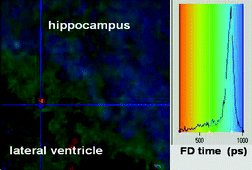Citation:
Abstract:
We present a method of mapping the water molecule distribution in mouse brain tissues using injected bis-N-carbazolyl-distyrylbenzene and the FLIM technique. The fluorescence lifetime of this two-photon absorbing chromophore diminishes when the amount of water in the surrounding area increases. The fluorescence lifetime of the injected in vivo chromophorestrongly depends on the content of water in different areas. Thus, lifetimes of 900 ± 50 ps in the hippocampus (extracellular fluid), 520 ± 50 ps in the lateral ventricle (choroid plexus, cerebrospinal fluid), and 400–150 ps in blood vessels were observed. Moreover, the fluorescence lifetime distribution undergoes drastic changes when mice are deprived of water. Statistical analysis of the investigated samples showed that upon water deprivation watercontent decreased at the border of the hippocampus/lateral ventricle areas and increased in blood vessels.


